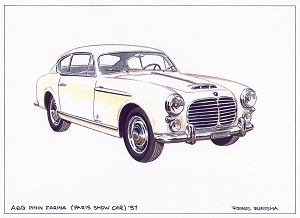| I Capolavori della Maserati
"An artist's journey through the Maserati roll of masterpieces" |
|
|
|
|
|
Rens Biesma Thanks to Dr. George Lipperts, a genuine Maserati enthusiast and collector, I am able to take you on a magical journey through the Maserati production years with some of the wonderful creations of the Maserati Carrozzieri through the unique artistic talents of Rens Biesma. |
|
| SET D - The Maserati A6G Variants (9 Prints) | |
 |
 |
 |
 |
|
At the Turin Motor Show of 1951 Maserati unveiled the logical successor to the A6, the A6G - the G stood for Ghisa (cast-iron) even though the block was made of light alloy. |
|
 |
 |
 |
 |
 |
|
|
The first Carrozziere to mount a body on the A6G chassis, derived from the successful A6GCS competition car, was Pinin Farina with a conservative four-seater coupé. Alongside this coupé was a carbriolet by Pietro Frua, this was the first of three models produced by Frua in 1951. |
|
| SET B - The Maserati A6G by Zagato (9 Prints) | |
 |
 |
 |
 |
|
Whilst the performance of the A6C was an improvement on the A6, it still did not satisfy the competition minded Maserati customer. It was with this in mind that Omer Orsi decided to capitalise on the racing successes of the A6GCS by introducing the A6G, a car powered by the same twin cam engine. As these prints show, the success of the A6G was largely down to the beautiful yet purposeful creations of Zagato. |
|
 |
 |
 |
 |
 |
|
|
Maserati invited 'Carrozzieri' to submit designs for the A6G and Zagato, Allemano and Frua offered a variety of body styles from which to choose. |
|
| THE JOURNEY CONTINUES | |
 |
|
To enter Enrico's Maserati Pages CLICK HERE! All illustrations are the sole copyright of FAL Duiven BV © 2003-2010 All rights reserved. Copyright: Enrico's Maserati Pages - © 2003-2010 All rights reserved. |